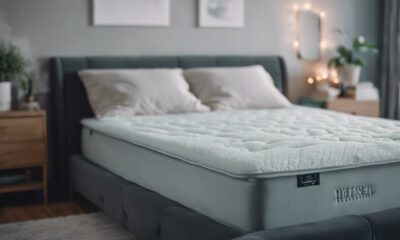Comforter
Can a Queen Comforter Fit a Full Bed
A Queen comforter can add warmth and style to a Full bed, but is it the perfect fit? Keep reading to find out!
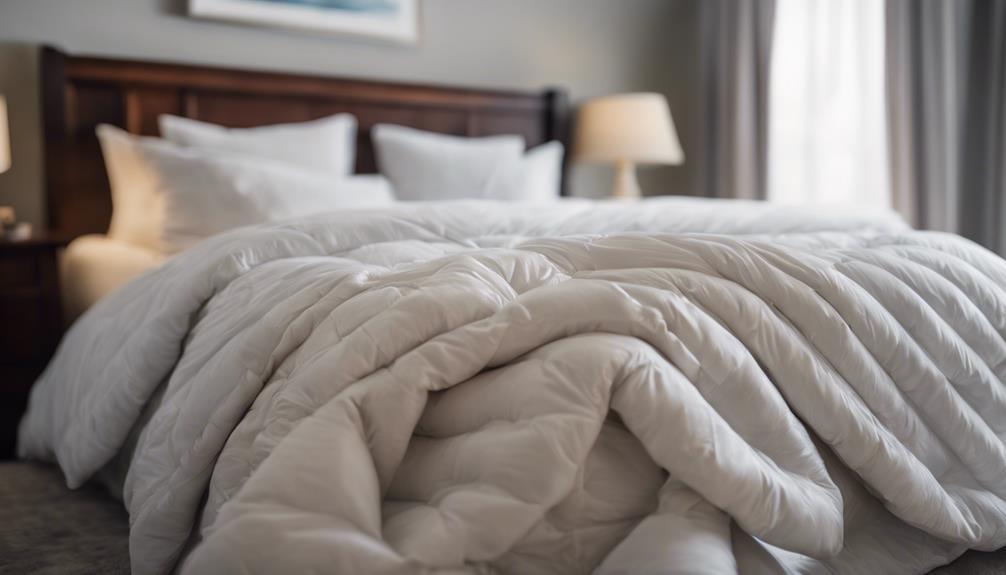
Yes, it is important to ensure the right size for both visual appeal and practicality when determining if a queen comforter can fit a full bed. The dimensions of a full bed are smaller than a queen comforter, so choosing a larger comforter for a full bed can provide extra warmth and coverage. Remember, the overhang can add a more luxurious appearance. For more information on optimizing the fit and aesthetics of a queen comforter on a full bed, continue reading about the benefits and considerations in the research.
Key Takeaways
- Queen comforter can fit a full bed but may hang over.
- Overhang provides extra warmth, coverage, and luxury.
- Larger dimensions offer increased comfort and aesthetics.
- Match queen comforter for stylish and cozy look.
- Consider compatibility for seamless integration and visual appeal.
Bed and Comforter Dimensions Comparison

Comparing the dimensions of a full bed and a queen comforter reveals a potential mismatch in size that can impact both aesthetics and functionality. A full bed typically measures 54 inches wide and 75 inches long, while a queen comforter is usually 88 inches wide and 88 inches long.
When placed on a full bed, a queen comforter can indeed fit, but it may hang over the sides due to the discrepancy in sizes. Despite the overhang, using a larger comforter on a full bed can offer increased warmth and coverage compared to a smaller one. It's essential to match the comforter size to the bed size for both visual appeal and practicality.
Utilizing a queen comforter on a full bed can introduce a touch of luxury and elevate the overall look of the bedding, making the sleeping space feel more inviting and cozy.
Adaptability of Queen Comforter on Full Bed
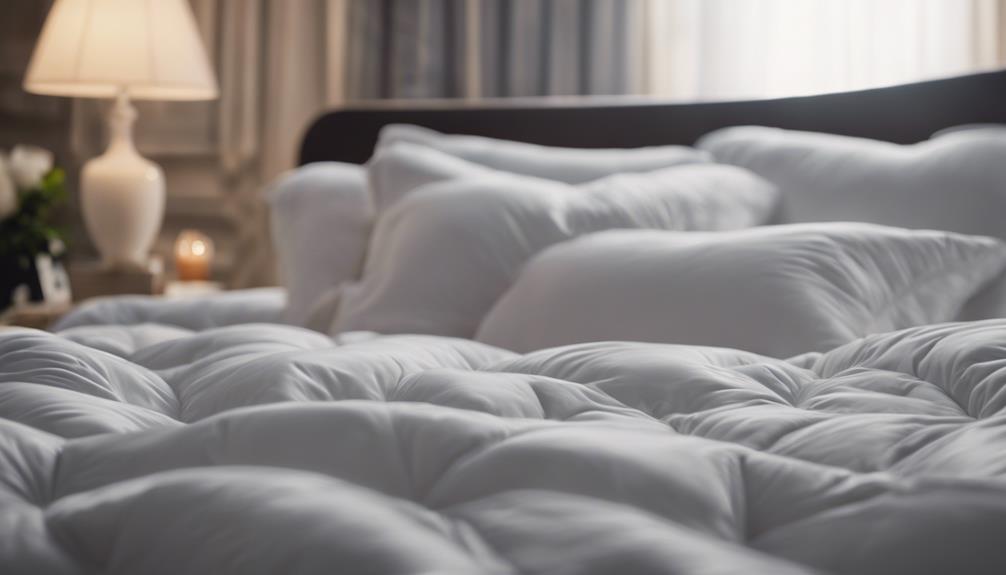
Queen comforters offer a versatile solution for full beds, given their larger dimensions.
The drooping effect of a queen comforter on a full bed can bring a touch of luxury to the bedroom.
Consider the overhang of the comforter when deciding between a queen or full size to guarantee complete coverage and visual appeal.
Size Compatibility Explained
When considering the adaptability of a queen comforter on a full bed, one can observe how the larger dimensions of the queen size comforter (typically 88 inches wide and 88 inches long) offer a luxurious and cozy aesthetic.
The extra fabric from a queen comforter on a full size bed can drape more generously, providing better coverage and warmth. Matching a queen comforter with a full bed is a common practice for those desiring a fuller, more elegant appearance in their bedroom.
The combination of a queen size comforter on a full bed creates a stylish and comfortable setting. This sizing compatibility allows for a seamless integration of the queen comforter, enhancing the overall look and feel of the bedding ensemble.
Bed Coverage Comparison
Exploring the fit of a queen comforter on a full bed reveals how the extra width can enhance bed coverage and create a more luxurious appearance. When comparing bed coverage between a queen comforter and a full bed, consider these points:
- The queen comforter's additional width can provide better coverage on a full bed.
- Using a queen comforter on a full bed may offer increased warmth and comfort, especially during colder seasons.
- The draped look of a queen comforter on a full bed can elevate the aesthetic of the bedroom, adding a touch of style and coziness.
- While a queen comforter can fit a full bed, the exact fit might vary depending on the specific dimensions of the comforter and the bed frame.
Comforter Overhang Considerations
Considering the adaptability of a queen comforter on a full bed, we can observe how the overhang contributes to a luxurious and cozy appearance. The overhang of a queen comforter on a full bed can provide extra warmth, coverage, and visual appeal, enhancing the overall aesthetic of the bedding ensemble. Below is a table illustrating the typical overhang of a queen comforter on a full bed:
| Aspect | Measurement |
|---|---|
| Overhang on Each Side | Approximately 14 inches |
| Total Overhang | Around 28 inches |
This overhang drapes elegantly over the sides of the bed, creating a snug and inviting look while ensuring comfort and warmth throughout the night.
Visual Impact of Using Queen Comforter

Using a queen comforter on a full bed instantly elevates the overall aesthetic with a luxurious draped effect. Here are four ways a queen comforter can visually impact the appearance of a full bed:
- Enhanced Size: The larger dimensions of a queen comforter compared to a full-sized one create a more substantial and grandiose look on the bed.
- Elegance and Style: The drooping effect of a queen comforter on a full bed adds a touch of elegance and sophistication to the bedroom decor.
- Better Coverage: Queen comforters provide improved coverage on a full-sized mattress, giving a more tailored and polished appearance.
- Upscale Feel: Opting for a queen comforter on a full bed can enhance the overall look of the bedding ensemble, offering a more refined and upscale feel.
Benefits of Using Queen Comforter

After discussing the visual impact of using a queen comforter on a full bed, let's now highlight the benefits that come with opting for this luxurious bedding choice.
A queen comforter offers several advantages when used on a full bed. To begin with, it provides better coverage and warmth due to its larger size compared to a full comforter. This extra fabric draping over the sides can create a cozy and inviting atmosphere in the bedroom.
Additionally, the drooping effect of a queen comforter on a full bed adds a touch of elegance and style, enhancing the overall aesthetic appeal of the bedding. Opting for a queen comforter for a full bed allows for a more generous and lavish appearance, making the bed look more luxurious and comfortable.
Same Size or Larger Comforter Choice
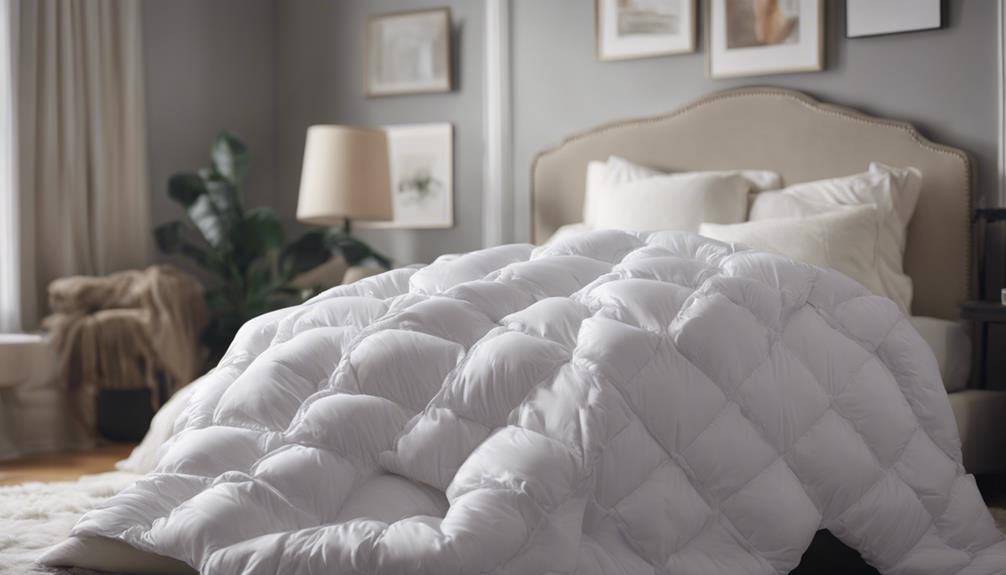
For a full bed, selecting a comforter that's the same size or larger than the bed can enhance both visual appeal and comfort. When deciding between a full or queen size comforter for your full bed, there are a few key considerations to keep in mind:
- Comforter Size: Make sure that the dimensions of the comforter match those of your full bed to prevent any ill-fitting or overhanging issues.
- Full or Queen Size: While a queen comforter can fit a full bed, it may offer more coverage and a luxurious draped look due to its larger size.
- Visual Appeal: Opting for a larger comforter can elevate the overall aesthetic of your bed and room, creating a more polished and cohesive appearance.
- Comfort Level: The additional size of a queen comforter on a full bed can provide extra warmth and coziness, enhancing your sleeping experience.
Consider your personal style preferences and the level of comfort you desire when choosing between a full or queen size comforter for your full bed.
Understanding Comforter and Duvet Differences

Understanding the distinctions between comforters and duvets is crucial for making informed bedding choices that cater to individual preferences and needs. Comforters are typically filled with natural or man-made fibers, providing warmth and coming in various sizes to fit different beds, including full or double sizes. On the other hand, duvets are filled with down for superior warmth and differ from comforters not only in material but also in warmth and cleaning requirements.
When considering a queen comforter for a full or double bed, it's crucial to recognize that duvets are often recommended for their luxurious warmth and cosiness. Understanding the differences between these bedding options allows for a more tailored selection that meets specific comfort and aesthetic preferences. By selecting the right type of bedding, whether a comforter or a duvet, individuals can enhance their overall sleeping experience and create a visually appealing bedroom setting.
Duvet Size Selection for Full Beds

Selecting the appropriate duvet size for a full bed requires careful consideration of the bed's dimensions to guarantee maximum comfort and aesthetics. When choosing a duvet size for a full bed, keep in mind the following key points:
- Full Bed Dimensions: Full beds typically measure 54 inches wide and 75 inches long, making it essential to choose a duvet size that fits these measurements snugly.
- Understanding Bed Dimensions: Having a good understanding of the dimensions of a full bed is vital for selecting the right duvet size that will provide adequate coverage and a polished look.
- Personal Preferences: Deciding whether to opt for a duvet the same size as the bed or one size larger depends on personal preferences and the desired aesthetic for the bedroom.
- Cosiness and Luxury: Opting for a larger duvet can enhance the cosiness, warmth, and luxurious appearance of a full bed, providing a more inviting and comfortable sleeping environment.
Matching Duvet Covers and Comforters

When it comes to bedding, matching duvet covers and comforters not only guarantee a snug fit but also contribute to a cohesive bedroom look.
Size compatibility with duvets, stylish coordination options, and functional benefits of matching play key roles in enhancing the overall bedding experience.
Size Compatibility With Duvets
In ensuring a proper fit and preventing shifting issues, matching duvet covers with comforters is essential. When considering size compatibility with duvets, several key points should be taken into account:
- Proper fit promotes even warmth distribution: Ensuring the duvet cover fits the comforter correctly helps maintain a consistent level of warmth across the bed.
- Impact on overall look and durability: Size compatibility influences not only the appearance but also the longevity of the bedding.
- Essential for comfort and quality of sleep: Choosing the right size is vital for a comfortable night's rest and ensuring the bedding functions as intended.
- Influences the tailored appearance of the bed: The size of the duvet cover can affect whether the bed has a neat, tailored look or a more relaxed, draped appearance.
Stylish Coordination Options
For an effortlessly coordinated bedroom ensemble, ensuring that your duvet cover and comforter match in style and color is essential. When selecting a queen comforter for a full bed, opt for a duvet cover that complements the comforter to create a cohesive look.
Matching these two elements not only enhances the overall aesthetics of your bedding but also helps prevent any slipping or shifting issues during use. Additionally, ensuring the duvet cover fits the queen comforter properly allows for even distribution of warmth across the full bed.
This stylish coordination not only elevates the visual appeal of your bedroom but also contributes to the durability and quality of your bedding ensemble.
Functional Benefits of Matching
Ensuring that duvet covers and comforters match provides significant benefits that enhance both the aesthetics and practicality of your bedding ensemble.
- Matching duvet covers and comforters ensures even warmth distribution across the bed.
- Proper size matching prevents slipping or shifting issues during use.
- Size matching is vital for maintaining the overall look and durability of the bedding.
- A well-fitted duvet cover enhances the comfort and quality of sleep.
Considerations When Purchasing Bedding

When purchasing bedding, consider the specific measurements to guarantee a perfect fit for your full bed. Taking into account the dimensions of a queen comforter, which typically has a width of 60 inches, and a full bed, which is around 54 inches wide, it's clear that a queen comforter can indeed fit a full bed.
The slight overhang of a queen comforter on a full bed can create a stylish and sophisticated appearance, adding a touch of luxury to your bedroom decor. Additionally, choosing a queen comforter on a full bed may provide better coverage and warmth, especially during colder seasons.
Manufacturers often design full and queen size comforters with the same dimensions, making them interchangeable in many cases. So, before making a purchase, make sure to check the specific measurements for the right fit and to enhance the aesthetic appeal of your full bed.
Bedroom Aesthetics With Queen Comforter

Enhancing the visual charm of a full bed, queen comforters drape elegantly, adding a touch of luxury to the bedroom decor. When it comes to bedroom aesthetics with a queen comforter on a full bed, there are a few key points to take into account:
- Luxurious Appearance: Queen comforters are designed to provide a more upscale look to a full bed, elevating the overall aesthetics of the bedroom.
- Enhanced Coverage: The larger size of a queen comforter compared to a full comforter can enhance the visual appeal by providing better coverage and a more luxurious appearance.
- Elegance and Sophistication: Using a queen comforter on a full bed adds an element of elegance and sophistication to the bedroom decor, making it a focal point of the room.
- Visual Appeal: The draped look of a queen comforter on a full bed creates a visually appealing and inviting atmosphere, making the bed a cozy retreat within the bedroom.
Frequently Asked Questions
Is a Queen Comforter Too Big for a Full Bed?
Yes, a queen comforter may be too big for a full bed in regard to size, but it can still be used effectively for added comfort and style. The extra fabric can provide warmth and a luxurious draped look.
Some people prefer the oversized appearance for aesthetic reasons. Even though it may hang over the sides, a queen comforter on a full bed can offer coziness and a touch of elegance.
Can You Use Queen Bedding on a Full Bed?
Yes, we can use queen bedding on a full bed. The size difference allows the queen comforter to drape over the sides, giving a luxurious look. This choice offers better coverage and warmth during colder months.
With a queen comforter being 88 inches wide, it comfortably fits the 54-inch width of a full bed. Opting for queen bedding on a full bed is popular for those who prefer a more generous fit and aesthetic appeal.
What Size Comforter for a Full Size Bed?
For a full-size bed, choose a full-size comforter measuring around 80 inches wide by 90 inches long. This size guarantees a proper fit without excessive overhang or bunching.
A full-size comforter is specifically tailored for full beds, offering ample coverage and comfort.
Remember to check the dimensions of the comforter before purchasing to ensure the best fit for your bed.
Should You Size up on a Comforter?
We've got an essential tip for you on comforter sizing.
When pondering whether to size up on a comforter, consider this: a larger comforter can offer added coziness and style.
By opting for a bigger size, you can enjoy more coverage and a draped look that elevates your bedroom decor.
Will a King Comforter Fit in a Washer Designed for Queen Comforters?
Yes, a washer designed for queen comforters should be able to handle washing a king comforter as long as it has a large enough capacity. It’s important to check the specifications of the washer to ensure it can accommodate the size and weight of a king comforter.
Conclusion
To sum up, a queen comforter can fit a full bed, providing extra comfort and warmth without compromising on style.
Just like a queen ruling over her kingdom, the queen comforter reigns supreme in versatility and adaptability.
So, whether you choose to use a same size or slightly larger comforter, your full bed will be transformed into a cozy and inviting sanctuary fit for royalty.
Choose wisely, and let your bedding reflect your regal taste.
Comforter
Can I Use a Down Comforter as a Mattress Topper
Optimize your sleep comfort with a down comforter as a mattress topper, offering luxurious softness and enhanced insulation – find out more!
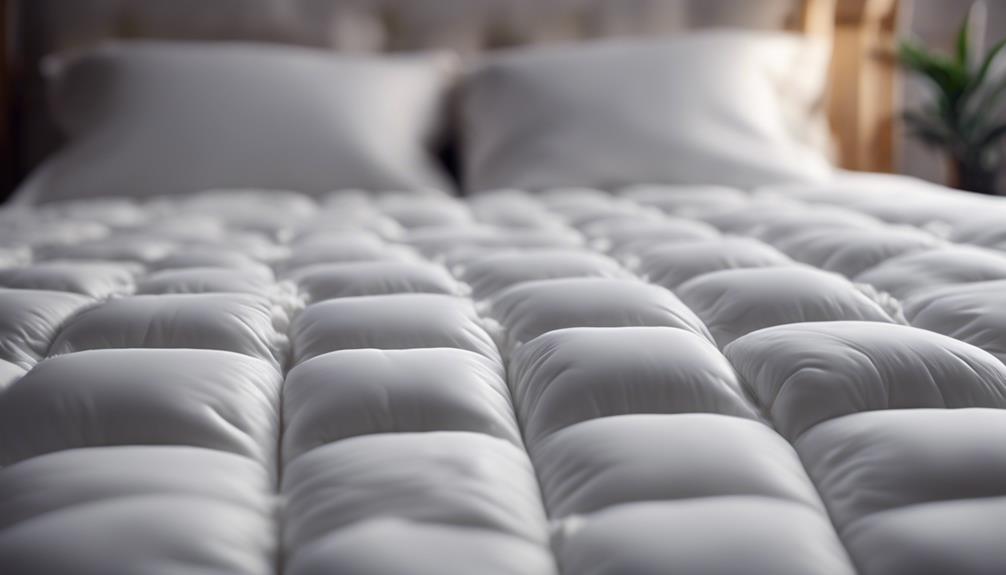
Using a down comforter as a mattress topper can improve the comfort and insulation of your bed. Placing it directly on top of the mattress underneath the fitted sheet allows it to conform to your body shape and provide a comfortable surface to sleep on. Before using, consider the thickness, fill power, and baffle box construction for the desired level of support. Regular cleaning and maintenance can help keep the down comforter feeling plush. Adding a down comforter to your bedding can add luxury and softness to your sleep, using white duck down for insulation. Its lightweight quality makes it easy to handle on the mattress. Learn more about the advantages and proper care to enhance your sleep experience.
Key Takeaways
- Down comforters can be used as mattress toppers for added comfort and warmth.
- Ensure the comforter fits the mattress size to provide effective coverage.
- Regularly rotate and fluff the comforter to maintain its plush feel.
- Consider using a cotton cover or duvet for extra protection.
- Enjoy the luxury and coziness of a down comforter as a versatile mattress topper.
Benefits of Using a Down Comforter
Using a down comforter as a mattress topper can greatly enhance the overall comfort and warmth of your bed. The feather-filled topper adds an extra layer of softness and coziness to your mattress, making for a more comfortable sleep experience.
The down filling, whether from geese or ducks, creates a plush feel that can help maintain body temperature while providing insulation during the night. This means you can stay warm and snug without feeling overheated.
By placing a down comforter on top of your mattress, you transform your bed into a haven of relaxation, perfect for unwinding after a long day. The topper's versatility allows for easy placement and removal, making it a convenient choice for those seeking a quick way to upgrade their sleep environment.
How to Properly Place a Down Comforter

To properly position a down comforter on your mattress for the best comfort and support, start by making sure it lies directly on top of the mattress under the fitted sheet. This positioning allows the down comforter, filled with luxurious white goose down, to adjust to your body contours, providing a cozy and supportive sleep surface. High-quality materials, such as Hungarian white goose down, offer extraordinary comfort, making your bed a sumptuous sanctuary for a restful night's sleep.
Proper placement of the down comforter is essential for maximizing its benefits. Regularly rotating the comforter and snapping it like a flat sheet can help redistribute the down evenly, maintaining its loft over time. By following these simple steps, you can guarantee that your down comforter remains plush and supportive, offering you a luxurious sleeping experience every night.
Factors to Consider Before Using

When contemplating using a down comforter as a mattress topper, evaluating its thickness and weight is vital to guarantee it offers the desired cushioning and support. The fill power of the comforter affects its fluffiness and insulating ability, so choose a fill power that suits your needs. Check if the comforter has baffle box construction to keep the down evenly distributed and prevent it from shifting. A cotton cover can help protect your mattress and provide a soft surface for sleeping. Make sure the comforter is the right size for your mattress to cover it effectively and stay securely in place.
Using a down comforter as a mattress topper can add extra warmth, which is beneficial in colder climates. However, it's important to take these factors into account before making the switch to ensure excellent comfort and functionality. By evaluating these elements, you can make an informed decision about using a down comforter as a mattress topper.
Cleaning and Maintenance Tips
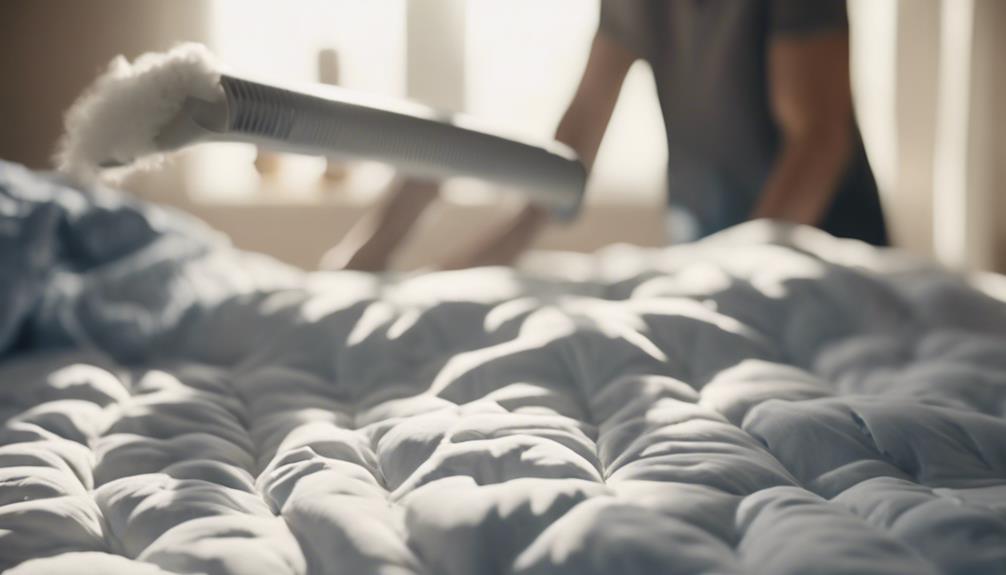
Regularly spot cleaning stains on your white goose down comforter mattress topper is vital to prevent them from setting and maintain its pristine condition. Using a feather bed protector can shield your down comforter from spills, dust, and allergens, extending its lifespan.
Remember to rotate your down comforter mattress topper periodically to guarantee even wear and prevent flat spots. Additionally, air out your down comforter mattress topper regularly to maintain freshness and fluffiness. Consider adding a duvet cover for added protection and easy cleaning.
Enhancing Comfort With a Down Comforter

Enhancing comfort with a down comforter as a mattress topper elevates the overall sleeping experience by providing an added layer of luxury and softness. White duck down, known for its exceptional insulating properties, creates a feather bed effect that's soft yet supportive.
When used as a mattress topper, a down comforter enhances the coziness of your bed, offering an inviting retreat at the end of a long day. The lightweight nature of down comforters makes them easy to manage on your mattress, ensuring a hassle-free experience.
Additionally, many down comforters are OEKO-TEX® certified, guaranteeing that they're free from harmful substances. This certification provides peace of mind regarding the quality and safety of the product you're using.
Frequently Asked Questions
Is Down Good for a Mattress Topper?
Down is excellent for a mattress topper due to its insulation and lightweight, fluffy nature. It offers a plush cushioning layer, enhancing your sleep experience with a luxurious feel.
Down's breathability helps regulate temperature for a comfortable rest. Overall, down is a cozy and comfortable choice that can elevate your mattress comfort level.
What Can I Use Instead of a Mattress Topper?
Instead of a mattress topper, we can explore alternatives like mattress pads, memory foam toppers, or even mattress protectors for added comfort. These options cater to various needs, such as extra cushioning, temperature regulation, or protection against allergens.
When choosing the best option to enhance our sleep quality and overall well-being, we must take into account our individual preferences and requirements.
Can I Use a Feather Duvet as a Mattress Topper?
Yes, a feather duvet can be used as a mattress topper. While it may not offer as much support as a traditional mattress topper, it can provide additional softness and comfort to your bed.
Feather duvets are known for their fluffiness and insulation properties, making your sleep experience cozier. Keep in mind that this makeshift solution may be temporary.
Using a feather duvet as a mattress topper can enhance your overall sleeping experience.
Is a Down Alternative Mattress Topper Hot?
Down alternative mattress toppers, like traditional down, regulate temperature well, making them a cooler option. They're designed with synthetic materials for breathability and cooling properties.
These toppers are typically hypoallergenic and suitable for allergy-prone individuals. Providing a balance of softness, support, and temperature control, they're an excellent choice for those seeking a comfortable night's sleep.
Is It Safe to Use Oxiclean on a Down Comforter That Can Also Be Used as a Mattress Topper?
Yes, it is safe to consider using Oxiclean on comforter or mattress topper made of down material. Oxiclean is a gentle yet effective cleaner that can remove stains and odors without damaging delicate fabrics like down. Just follow the label instructions and spot test first to ensure compatibility.
Conclusion
To sum up, utilizing a down comforter as a mattress topper can offer additional comfort and warmth to enhance your sleep experience.
Were you aware that research has indicated that sleeping with a down comforter can aid in improving the quality of sleep by regulating body temperature?
Therefore, if you're seeking a snug and indulgent solution to upgrade your mattress, consider utilizing a down comforter as a mattress topper for a more restful night's sleep.
Mason – Your Product Expert Mason is your go-to product expert, carefully selecting each item in our collection to ensure it meets your comfort, functionality, and style needs. With his attention to detail and commitment to quality, he ensures that every product we offer enhances your home experience.
Comforter
Can Comforters Get Bed Bugs
Fend off potential bed bug infestations by learning how comforters can harbor these pests, leading to effective prevention strategies.

Yes, comforters can contain bed bugs in their fabric, seams, and folds. These small insects survive on human blood and are most effectively eradicated by using high heat treatment in the dryer. Temperatures exceeding 120°F for 30 minutes kill bed bug eggs, nymphs, and adults efficiently. It is vital to regularly check for indicators like bloodstains and eggshells. Washing in hot water and drying at high heat can aid in getting rid of bed bugs. Keeping clean comforters sealed in plastic bags can prevent re-infestation. To ensure a bed bug-free space, consider investing in protective encasements made of bed bug-resistant materials. Protect yourself from infestations successfully.
Key Takeaways
- Bed bugs infest comforters in seams, folds, and fabric.
- Washing in hot water and high heat drying kills bed bugs.
- Sealing clean comforters in plastic bags prevents re-infestation.
- Regularly inspect for signs like bloodstains and small insects.
- Use protective encasements to create a bed bug barrier.
Understanding Bed Bugs in Comforters

When it comes to understanding bed bugs in comforters, it's crucial to recognize that these pests can easily infest and hide within the fabric, seams, and folds of the bedding. Bed bugs are tiny insects that feed on human blood and are skilled at finding cozy spots to nest, making comforters an ideal environment for them to lay eggs and thrive.
To combat bed bugs in comforters, utilizing high heat treatment in the dryer is a highly effective method to kill bed bug eggs, nymphs, and adults. By subjecting the comforter to temperatures above 120°F for at least 30 minutes, you can guarantee that the entire infestation is eradicated. High heat is a natural and chemical-free approach that's safe for most comforter materials.
It's important to remember that sealing clean comforters in durable plastic bags can also provide protection against bed bug infestations, preventing these pests from infiltrating your bedding and causing further issues.
Signs of Bed Bug Infestation

To detect a bed bug infestation in your comforter, carefully inspect for small, flat insects, droppings, bloodstains, red or brown stains, ivory-colored eggshells, live bed bugs, or dark brown fecal spots.
Look closely at the seams and folds of the comforter where bed bugs like to hide. If you notice tiny insects resembling apple seeds, dark spots or smears that could be bed bug feces, or red and brown stains that might be blood from crushed bugs, these could all be signs of a bed bug infestation.
Additionally, ivory-colored eggshells or live bed bugs near areas where you sleep are strong indicators of a problem. Pay attention to any itchy red skin or bite marks you might've after using the comforter, as these could also signal the presence of bed bugs.
Regularly checking for these signs can help you catch a bed bug infestation early and take appropriate action to address the issue promptly.
Prevention Tips for Comforters
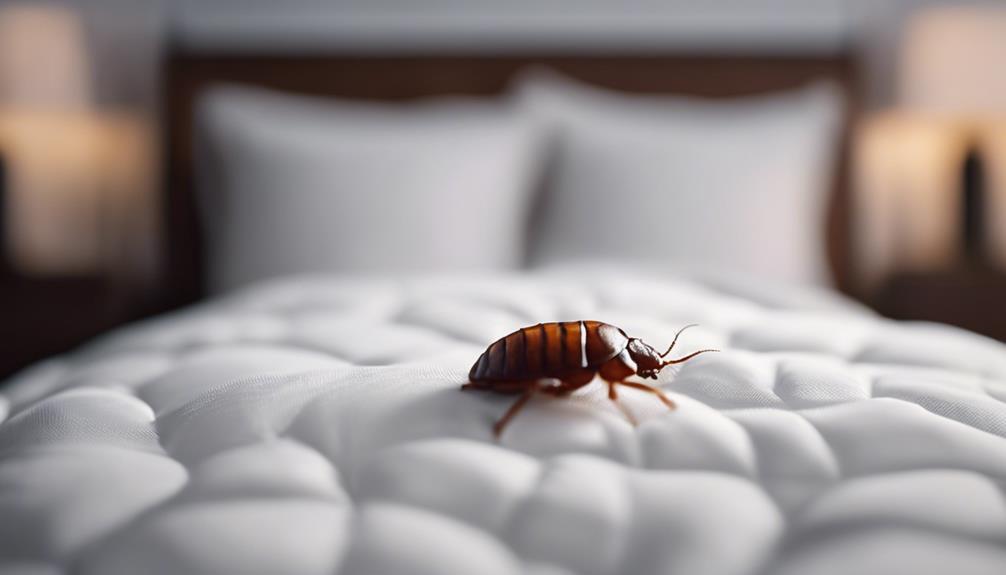
Wondering how to keep your comforter free from bed bugs? To prevent a bed bug infestation in your comforter, there are several proactive steps you can take.
First, regularly inspect your comforter for any signs of bed bugs, such as small reddish-brown stains or tiny dark spots that could indicate their presence. Washing your comforter in hot water and drying it on high heat can help eliminate any potential bed bugs and their eggs. Additionally, sealing your clean comforter in a plastic bag after washing can help reduce the risk of re-infestation.
It's also essential to keep your sleeping area clean and clutter-free, as bed bugs thrive in messy environments. By regularly cleaning your bedding, vacuuming your mattress and bed frame, and minimizing hiding spots for bed bugs, you can significantly lower the likelihood of an infestation in your comforter.
Washing and Treating Infested Comforters

If comforters become infested with bed bugs, the most effective way to eliminate them is by washing the comforter in hot water and drying it on high heat. Heat is bed bugs' worst enemy, as it kills them at all stages of life – eggs, nymphs, and adults. Here is a simple guide to help you effectively wash and treat an infested comforter:
| Steps to Wash and Treat Infested Comforters |
|---|
| 1. Wash the comforter in hot water |
| 2. Dry the comforter on high heat |
| 3. Seal the clean comforter in a durable plastic bag to prevent re-infestation |
When dealing with bed bugs, it's important to remember that washing and drying alone may not be enough. Make sure to also inspect your bed bug mattress and surrounding areas for any signs of infestation. If the problem persists, seeking professional help is the best course of action to ensure thorough removal and treatment.
Using Protective Encasements for Comforters

When seeking additional protection against bed bug infestations in comforters, consider using protective encasements made of durable, bed bug-proof materials. These encasements act as a barrier that makes it difficult for bed bugs to penetrate and hide in the comforter, providing a proactive approach to preventing infestations.
Typically crafted from sturdy, bed bug-proof fabrics, these encasements offer a reliable shield for your comforter. By investing in encasements for your comforters, you can enjoy peace of mind knowing that your bedding is safeguarded against potential bed bug problems.
Remember to regularly inspect and clean encased comforters to maintain a bed bug-free environment effectively. This simple step can greatly contribute to the longevity of your comforter and ensure a hygienic sleeping space.
Frequently Asked Questions
How Can I Tell if My Bedding Has Bed Bugs?
To determine if your bedding has bed bugs, look for brown or red stains, which are droppings and blood respectively. Check for small, flat insects or shed skins. A musty odor and red, itchy bites may also indicate their presence.
If you suspect bed bugs, consider professional inspection and treatment. DIY methods may not completely eliminate the infestation. It's vital to act promptly to prevent further spread and discomfort.
Should I Throw Away My Pillows if I Have Bed Bugs?
If bed bugs infest your pillows, addressing the issue promptly is crucial. Inspect for signs like dark spots, eggs, or live bugs.
Consider professional pest control for effective treatment. Throwing away pillows may not be necessary; proper treatment and encasement can prevent spread and reinfestation.
Act swiftly to control the situation and protect against further bed bug problems.
How Do I Protect My Bed Bugs From My Bedding?
To safeguard bedding from bed bugs, we recommend a proactive approach. Start by regularly washing and drying your bedding on high heat to kill any potential bugs or eggs.
Additionally, seal clean bedding in durable plastic bags to prevent reinfestation. Avoid using insecticide sprays, as they may not be effective and could harm the fabric.
Taking these preventive steps can help protect your bedding from bed bugs and guarantee a restful night's sleep.
How Do You Get Bed Bugs Out of Blankets?
To get bed bugs out of blankets, we recommend placing the blanket in the dryer on high heat. This will effectively kill eggs, nymphs, and adult bed bugs.
After treatment, seal the clean blanket in a durable plastic bag to prevent reinfestation.
Avoid using insecticide sprays as they can be ineffective and leave stains and odors.
For challenging infestations, seek professional pest control help for thorough removal.
Are Comforters a Common Hiding Place for Bed Bugs?
Yes, comforters are a common hiding place for bed bugs. These pesky insects can easily burrow into the folds and seams of the fabric, making it difficult to spot them. Combating bed bug infestations requires thorough cleaning and regular inspections of bedding and furniture.
Conclusion
To sum up, comforters can indeed attract bed bugs if not properly cared for. Just like a cozy blanket that keeps us warm, comforters can unknowingly harbor these pesky pests.
By being vigilant for signs of infestation, practicing prevention techniques, and washing and treating infested comforters promptly, we can guarantee a bed bug-free sleep environment.
Remember, just as we take care of ourselves, it's important to also take care of our bedding to keep those bed bugs at bay.
Comforter
What Size Duvet Cover for Queen Down Comforter
Looking for the perfect duvet cover for your queen down comforter? Let's explore how the right size can transform your bedding experience.

For a queen down comforter, choose a queen-sized duvet cover measuring 90 inches by 96 inches. This size guarantees a snug and seamless fit, allowing the comforter to drape nicely over the edges of the bed. Opting for the correct size prevents shifting and maintains a neat appearance. Corner ties secure the comforter in place for better sleep. If you want to enhance comforter loft and prevent bunching, matching cover and comforter sizes is essential. Discover how different duvet cover sizes cater to various comforter sizes and styles.
Key Takeaways
- Choose a queen-sized duvet cover measuring 90×96 inches for a snug fit.
- Prevent shifting with corner ties in the cover for better sleep.
- Optimal cover fit ensures a neat appearance and proper coverage.
- Enhance comforter loft with a snugly fitting duvet cover.
- European Queen size covers from Plumeria Bay cater to queen down comforters.
Matching Duvet Cover Size
When selecting a duvet cover for a queen down comforter, make sure to choose a queen-sized duvet measuring 90 inches x 96 inches. Matching the size is important to guarantee proper fit and coverage for your queen down comforter.
Using a duvet cover that's too small may result in inadequate coverage, leaving parts of the comforter exposed. By opting for a queen-sized duvet cover, you secure a seamless and snug fit for your comforter. This size provides the ideal dimensions to accommodate your queen down comforter comfortably, allowing it to drape nicely over the edges of the bed.
Additionally, a queen-sized duvet cover enhances the overall aesthetic of your bedding, giving it a neat and polished look. Therefore, always prioritize selecting the correct size when choosing a duvet cover for your queen down comforter to ensure both functionality and style.
Importance of Cover Fit

Ensuring the duvet cover fits snugly over the queen down comforter is vital for maintaining a tidy and comfortable bedding arrangement. Here are some key points to keep in mind:
- Properly fitting covers prevent shifting, ensuring a neat appearance.
- Choosing a queen size cover, typically 90×96 inches, matches the dimensions of the comforter.
- Opting for a cover slightly smaller than the comforter can enhance loftiness and snugness.
- Corner ties in the duvet cover help secure the comforter in place, preventing discomfort during sleep.
- Matching the size of the duvet cover to the queen down comforter is essential for a well-coordinated and visually appealing bedding ensemble.
Enhancing Comforter Loft

To maximize the loftiness of your queen down comforter, selecting a duvet cover that fits snugly and complements its dimensions is crucial. Choosing a queen size duvet cover that matches the size of your comforter guarantees a perfect fit, enhancing both comfort and aesthetic appeal in your bedroom.
Consider opting for a slightly smaller duvet cover for a snug fit, which can boost the comforter's loftiness. Look for duvet covers with corner ties as they help secure the comforter in place and prevent shifting inside the cover.
Additionally, German size and super size duvet covers are available to accommodate different comforter sizes, providing options to suit your specific needs. By properly fitting your down comforter with the right size duvet cover, you can elevate both the comfort level and the visual appeal of your bedding ensemble.
Preventing Shifting Inside Cover

In securing a down comforter within a duvet cover, corner ties play an important role in preventing shifting and maintaining a neat appearance. Corner ties help keep the comforter in place, making sure it doesn't bunch up or move around inside the cover.
To prevent shifting, it's vital to choose a duvet cover that fits the queen down comforter properly. Opt for a snug fit by selecting a cover that matches the dimensions of the comforter. This way, the comforter stays in place, providing a comfortable and consistent sleeping experience.
- Corner ties: Essential for preventing shifting inside the cover.
- Proper fit: Choose a duvet cover that matches the queen down comforter size.
- Neat appearance: Ensures the comforter stays in place for a tidy look.
- Preventing bunching: Corner ties help maintain even coverage.
- Comfortable sleep: A snug fit enhances comfort and prevents discomfort caused by shifting.
Plumeria Bay Options

For a perfect fit with your queen down comforter, consider the European Queen size duvet covers available from Plumeria Bay. These duvet covers are specifically designed to accommodate queen down comforters, ensuring a snug and tailored fit. The dimensions of the European Queen size duvet cover, measuring 95 x 87 inches, make it ideal for your queen down comforter. What's great is that these covers are customizable, allowing you to personalize your bedding while ensuring it stays in place and looks neat.
Plumeria Bay offers discounted prices on their European Queen size duvet covers, making it a cost-effective choice for enhancing both the comfort and style of your bedroom. By opting for a European Queen size duvet cover from Plumeria Bay, you can rest assured that your queen down comforter will be well-protected and beautifully complemented.
Easy Fitting for Comfort and Style

With a queen-sized down comforter typically measuring 90 inches by 94 inches, selecting a duvet cover that measures 90 inches by 96 inches guarantees a perfect fit for both comfort and style. Here are some key points to keep in mind for easy fitting and a plush look:
- Opt for a slightly larger duvet cover to achieve a luxurious and comfortable appearance.
- Make sure the duvet cover has corner ties to keep the queen-sized comforter securely in place.
- Matching the sizes of the duvet cover and comforter will result in a seamless and stylish fit.
- A queen-sized duvet cover measuring 90 inches by 96 inches is the ideal choice for a perfect fit.
- By following these tips, you can effortlessly enhance the comfort and style of your bedding with the right duvet cover for your queen size down comforter.
Frequently Asked Questions
What Size Duvet Cover for Queen Comforter?
When choosing a duvet cover for a queen comforter, opt for one that matches the queen size dimensions, typically 90 inches by 96 inches. Make sure it's large enough to fit the comforter properly.
Consider an oversized cover for a luxurious look. Look for corner ties to keep the comforter in place. Check dimensions of both comforter and cover for compatibility.
Compatibility guarantees a snug and comfortable fit.
What Size Duvet Cover for Down Comforter?
When selecting a duvet cover for a down comforter, it's important to match the dimensions for a proper fit. Look for a queen size duvet cover that corresponds to the size of the comforter, usually around 90 by 94 inches.
Opt for one with corner ties to secure the comforter in place. Choose a cover slightly larger than the comforter for a snug fit. Verify the exact measurements to avoid any fitting issues.
Should Your Duvet Cover Be the Same Size as Your Duvet?
We always recommend choosing a duvet cover that matches the size of your duvet for the best fit and comfort. Having a duvet cover that's the same size as your duvet guarantees that it will stay in place and provide even coverage. This compatibility prevents shifting and guarantees a snug fit.
Should I Put My Down Comforter in a Duvet Cover?
We always recommend putting your down comforter in a duvet cover. It helps protect the comforter from dirt, stains, and wear, and makes cleaning easier since you can simply remove and wash the cover.
Plus, a duvet cover can enhance the appearance of your bedding and add a decorative touch to your bedroom. Opting for a duvet cover is a smart choice that adds style, comfort, and longevity to your bedding.
What Size Duvet Cover Do I Need for a Full Bed with a Queen Comforter?
When choosing a duvet cover for a full bed with a queen comforter, it’s best to opt for a cover designed for a queen comforter. This will ensure a proper fit and prevent any bunching or discomfort. A queen-sized duvet cover will provide ample coverage and a snug fit for your queen comforter on a full-sized bed.
Conclusion
When choosing a duvet cover for your queen down comforter, it's important to select the right size to enhance comfort and prevent shifting.
For example, a queen-sized duvet cover from Plumeria Bay offers a perfect fit for your comforter, ensuring both style and functionality.
By choosing the right size, you can enjoy a cozy and stylish bedroom setup that will keep you comfortable all night long.
Mason – Your Product Expert Mason is your go-to product expert, carefully selecting each item in our collection to ensure it meets your comfort, functionality, and style needs. With his attention to detail and commitment to quality, he ensures that every product we offer enhances your home experience.
-

 Vetted6 months ago
Vetted6 months ago14 Best Personalized Father's Day Gifts for Your Husband – Show Him You Care
-

 Vetted7 months ago
Vetted7 months ago15 Best EMS Foot Massagers for Neuropathy to Soothe Your Feet
-

 Alfresco6 months ago
Alfresco6 months agoAlfresco Stacker Doors: Seamless Indoor-Outdoor Living!
-

 Tableware and Dining Accessories7 months ago
Tableware and Dining Accessories7 months agoWhat Is the Meaning of the Word Tableware
-

 Tableware and Dining Accessories7 months ago
Tableware and Dining Accessories7 months agoWhen Is Tableware on Sale at Hobby Lobby
-

 Tableware and Dining Accessories7 months ago
Tableware and Dining Accessories7 months agoWhich of the Following Is Not Classified as Tableware
-

 Craft and Textiles7 months ago
Craft and Textiles7 months ago15 Best Places to Buy Appliances for Your Home – Top Retailers Reviewed
-

 Vetted6 months ago
Vetted6 months agoBattle Born Batteries Review: Reliable Power Solution














